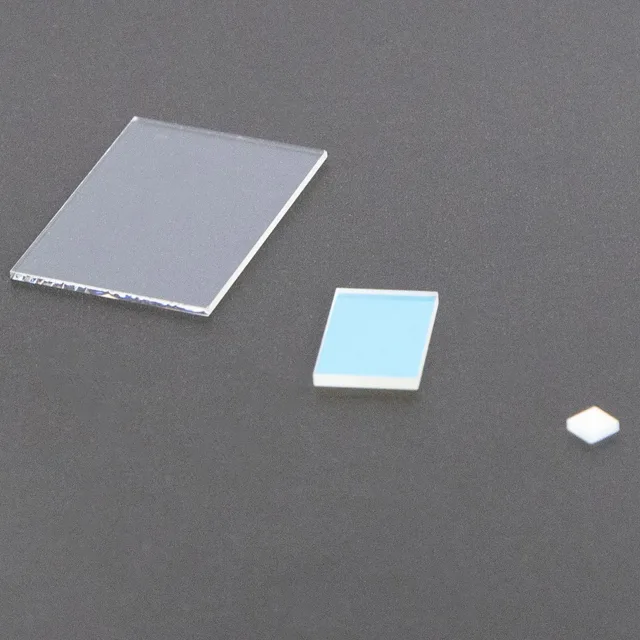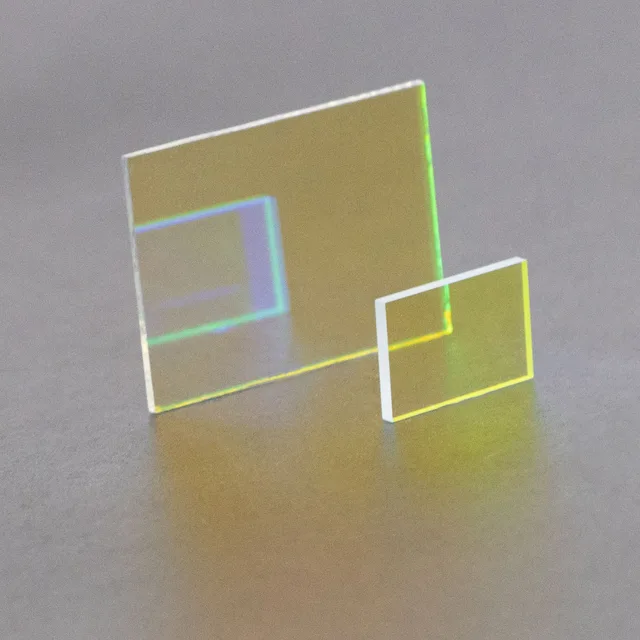Dichroic mirrors, also known as dichroic filters, are optical devices that reflect certain wavelengths of light while transmitting others. They are used in a wide variety of optical systems because of their ability to selectively manage light based on wavelength.
In this article, we’ll explore the many applications of dichroic mirrors in fields such as microscopy, photography, laser systems, and entertainment lighting and how to choose the right dichroic mirror for your application. Let’s read on!
How Dichroic Mirrors Work?

The working principle of a dichroic mirror is mainly composed of multiple layers of dielectric material thin films, each with a different refractive index. These layers will produce interference effects, which determine which wavelengths of light will be transmitted and which will be reflected. The number of layers and the materials used will affect the effective spectral range of the mirror.
The selective reflective and transmissive properties of dichroic mirrors make them ideal for applications that require precise control of the light path. The performance of a mirror is characterized by factors such as transmission efficiency, reflective range, and blocking ability.
Applications of Dichroic Mirrors
Dichroic mirrors are used in many applications because of their many advantages. Let’s take a closer look at some of the roles of dichroic mirrors in fluorescence microscopy, laser systems, photography, and spectroscopy!
1. Fluorescence Microscopy
In fluorescence microscopy, dichroic mirrors are used to separate excitation and emission light to ensure clear fluorescence imaging. The excitation light is usually short wavelength light (such as UV or blue light), which the dichroic mirror reflects to the sample to excite a fluorescent dye. The longer wavelength light emitted by the fluorescent dye (e.g., green or red light) is then transmitted through the dichroic mirror to the detector.
This optical separation improves the contrast and signal-to-noise ratio of the image, which helps to observe cellular structures and dynamic processes in biological research. For example, in multiple fluorescent labeling experiments, dichroic mirrors can separate different wavelengths of fluorescence through multiple channels to improve imaging efficiency.
2. Laser Systems
Dichroic mirrors are used in laser applications to combine or separate laser beams of multiple wavelengths, especially important when multiple laser systems are required. Dichroic mirrors can combine laser beams of different wavelengths on the same optical path, or they can separate specific wavelengths of laser lines and direct them to different paths.
For example, in Raman spectrometers and laser confocal microscopes, dichroic mirrors can achieve reflectance or transmittance above 95%, resulting in a significant increase in the energy utilization of the optical system. As a result, it is often used in applications with high precision requirements such as scientific research, medical laser surgery, and industrial laser processing (e.g., laser cutting and welding).
3. Spectroscopy
In spectroscopy, dichroic mirrors direct light of different wavelengths to different detectors or optical paths. This wavelength selectivity makes dichroic mirrors an important tool for studying the spectral properties of materials.
For example, in Near Infrared Spectroscopy (NIR) analysis, dichroic mirrors can help separate the visible and NIR spectra to improve the sensitivity of detection and accuracy of quantitative analysis of a sample.
4. Entertainment Lighting
Dichroic lenses are commonly used in stage and architectural lighting for precise control of light color. Compared to traditional color filters, dichroic lenses can produce more vibrant and fade-free light effects.
For example, with the use of dichroic lenses in theater lighting, color saturation can reach over 90%, making stage performances more vivid. Because dichroic mirrors reflect and transmit specific wavelengths of light, they can create rich color effects for different scenes. Suitable for theater, concerts, art installations, and building facade lighting.
5. Optical Coherence Tomography (OCT)
In an OCT system, dichroic mirrors help to separate the reference beam from the sample beam.OCT technology is widely used in ophthalmic diagnostics to generate high-resolution images of the retina to help doctors detect and treat eye diseases such as glaucoma and macular degeneration.
By using dichroic mirrors to separate wavelengths, OCT systems are able to focus and process tissue layers at different depths more efficiently, enabling precise imaging with resolutions as high as 5-10 microns.
Advantages and Limitations of Dichroic Mirrors

1. Advantages
- Higher transmission efficiency and reflectivity for specific wavelength ranges.
- Dichroic mirrors reflect and transmit different wavelengths of light efficiently, making them suitable for applications that separate spectra, such as fluorescence microscopy, spectral analysis, and stage lighting.
- Durable, as the coating will not fade like conventional color filters.
- The whole angle of incidence, allows adjustment of the reflective and transmissive spectral characteristics of dichroic mirrors to suit different optical system designs.
- Applications are wide-ranging and cover a variety of fields.
- Dichroic mirrors can be customized for specific wavelength ranges, dimensions, and reflection/transmission requirements, providing flexibility for a variety of specialized needs.
2. Limitations
- Performance is highly wavelength-dependent; dichroic mirrors designed for one application may not be suitable for other applications.
- Angular sensitivity: the effectiveness of the mirror will vary depending on the angle of incidence.
- Coating materials may degrade in high temperatures, humidity, or chemical environments; proper storage and use environments are required.
Comparison with Other Optical Filters
Dichroic filters offer better wavelength selectivity and efficiency than standard filters and beamsplitters. Standard color filters separate the spectrum by absorbing unwanted wavelengths, which leads to heat buildup and energy loss.
Dichroic mirrors reflect unwanted wavelengths, which reduces heat buildup and energy loss and improves the overall energy efficiency of the optical system. This makes them more suitable for applications that require high optical energy transmission, such as laser systems and fluorescence microscopes.
Dichroic mirrors also offer lower background noise and better spectral stability than other optical filters, giving them a unique advantage in spectral analysis and laser tuning applications. At the same time, due to the durability of their optical coatings and the tunability of their reflective efficiency, dichroic mirrors maintain more consistent performance in harsh environments.
Choosing the Right Dichroic Mirror
When choosing the right dichroic mirror for your specific application, you can refer to the following perspectives to make your choice:
1. Wavelength Range
The primary function of a dichroic mirror is to reflect light of a specific wavelength and transmit other wavelengths. Therefore, you must consider choosing the right wavelength range when making your selection. For example, in fluorescence microscopy, dichroic mirrors need to match the excitation and emission wavelengths of fluorescent dyes.
2. Reflection and Transmission Efficiency
A high-quality dichroic mirror should have high reflection efficiency (usually greater than 90%) in a given wavelength range and high transmission efficiency in other wavelength ranges.
The reflectance and transmission spectra of a dichroic mirror can be known well in advance of purchase to ensure that it is meeting the performance needs of your system.
3. Angular Dependence
The performance of a dichroic mirror may vary with the angle of incident light, which is typically 45°. For different optical systems such as microscopes, projectors, or lasers, the reflection and transmission characteristics of the mirror at the designed angle need to be considered.
4. Optical Quality
If the application requires high-resolution optics (e.g. confocal microscope), a dichroic mirror with high optical quality should be selected to minimize optical aberration and scattering.
5. Material and Coating Durability
Consider the durability of the dichroic mirror’s material (e.g., glass or quartz) and coating, especially when used in high-power laser systems or harsh environments. Some materials may be more sensitive to heat, humidity, or chemicals.
6. Size and Shape
Make sure the size of the dichroic mirror you choose is appropriate for your optical system. If the standard dimensions do not meet the requirements, you can contact Optolong to customize the right dichroic mirror size for you.
7. Application Scenarios
Different applications require different dichroic mirrors. For example, a stage lighting system may require higher heat resistance, while a microscope requires a high optical-quality mirror. Depending on the specific application scenario, choose the right type of dichroic mirror.
Considering these factors can help you choose the best dichroic mirror for a specific application to optimize the performance of your optical system.
Optolong’s Dichroic Mirrors
Optolong’s dichroic lenses are capable of efficiently reflecting specific wavelengths of light and transmitting other wavelengths. These lenses are widely used in fluorescence microscopy, laser systems, astronomy, and photography to improve image quality and accuracy of spectral separation.
Optolong’s dichroic lenses use advanced multi-layer coating technology to ensure high reflectance and transmittance while reducing the effects of light loss and stray light for the high-performance needs of professional optical systems.
In addition, optolong is supportive of customized dichroic mirrors. If you have a need, please feel free to contact us for any of your needs!
Related reading: What is a dichroic mirror?
